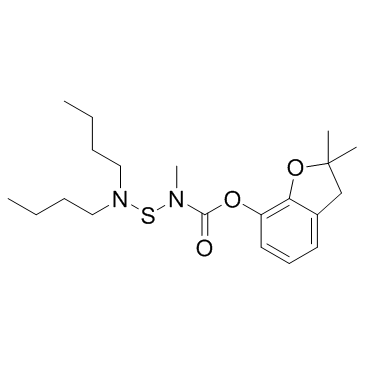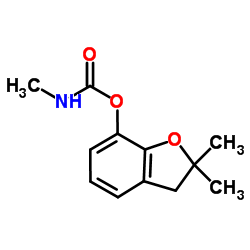55285-14-8
| Name | carbosulfan |
|---|---|
| Synonyms |
2,3-dihydro-2,2-dimethyl-7-benzofuranyl N-[(dibutylamino)thio]-N-methylcarbamate
marshall Carbosulfan Sheriff MARSHAL 2,3-dihydro-2,2-dimethylbenzofuran-7-yl (dibutylaminothio)methylcarbamate AMITAGE DBSC EINECS 259-565-9 MFCD00143930 2,2-dimethyl-2,3-dihydro-1-benzofuran-7-yl [(dibutylamino)sulfanyl]methylcarbamate Posse Versal BRIGHT |
| Description | Carbosulfan inhibited relatively potently CYP3A4 and moderately CYP1A1/2 and CYP2C19 in pooled HLM (human livers). Carbosulfan activation is predominantly catalyzed in humans by CYP3A4. |
|---|---|
| Related Catalog | |
| References |
| Density | 1.1±0.1 g/cm3 |
|---|---|
| Boiling Point | 462.5±55.0 °C at 760 mmHg |
| Molecular Formula | C20H32N2O3S |
| Molecular Weight | 380.545 |
| Flash Point | 233.5±31.5 °C |
| Exact Mass | 380.213348 |
| PSA | 67.31000 |
| LogP | 6.05 |
| Vapour Pressure | 0.0±1.1 mmHg at 25°C |
| Index of Refraction | 1.540 |
|
SECTION 1: Identification of the substance/mixture and of the company/undertaking Product identifiers Product name: Carbosulfan REACH No.: A registration number is not available for this substance as the substance or its uses are exempted from registration, the annual tonnage does not require a registration or the registration is envisaged for a later registration deadline.
CAS-No.: 55285-14-8 Relevant identified uses of the substance or mixture and uses advised against Identified uses: Laboratory chemicals, Manufacture of substances SECTION 2: Hazards identification Classification of the substance or mixture Classification according to Regulation (EC) No 1272/2008 Acute toxicity, Oral (Category 3), H301 Acute toxicity, Inhalation (Category 2), H330 Skin sensitisation (Category 1), H317 Acute aquatic toxicity (Category 1), H400 Chronic aquatic toxicity (Category 1), H410 For the full text of the H-Statements mentioned in this Section, see Section 16. Classification according to EU Directives 67/548/EEC or 1999/45/EC T ToxicR25 R43 N Dangerous for theR50/53 environment T+ Very toxicR26 For the full text of the R-phrases mentioned in this Section, see Section 16. Label elements Labelling according Regulation (EC) No 1272/2008 Pictogram Signal wordDanger Hazard statement(s) H301Toxic if swallowed. H317May cause an allergic skin reaction. H330Fatal if inhaled. H410Very toxic to aquatic life with long lasting effects. Precautionary statement(s) P260Do not breathe dust/ fume/ gas/ mist/ vapours/ spray. P273Avoid release to the environment. P280Wear protective gloves. P284Wear respiratory protection. P301 + P310IF SWALLOWED: Immediately call a POISON CENTER or doctor/ physician. P310Immediately call a POISON CENTER or doctor/ physician. Supplemental Hazardnone Statements Other hazards - none SECTION 3: Composition/information on ingredients Formula: C20H32N2O3S Molecular Weight: 380,5 g/mol Hazardous ingredients according to Regulation (EC) No 1272/2008 ComponentClassificationConcentration Carbosulfan CAS-No.55285-14-8Acute Tox. 3; Acute Tox. 2;<= 100 % EC-No.259-565-9Skin Sens. 1; Aquatic Acute 1; Index-No.006-084-00-5Aquatic Chronic 1; H301, H317, H330, H410 Hazardous ingredients according to Directive 1999/45/EC ComponentClassificationConcentration Carbosulfan CAS-No.55285-14-8T+, N, R25 - R26 - R43 -<= 100 % EC-No.259-565-9R50/53 Index-No.006-084-00-5 For the full text of the H-Statements and R-Phrases mentioned in this Section, see Section 16 SECTION 4: First aid measures Description of first aid measures General advice Consult a physician. Show this safety data sheet to the doctor in attendance. If inhaled If breathed in, move person into fresh air. If not breathing, give artificial respiration. Consult a physician. In case of skin contact Wash off with soap and plenty of water. Take victim immediately to hospital. Consult a physician. In case of eye contact Flush eyes with water as a precaution. If swallowed Never give anything by mouth to an unconscious person. Rinse mouth with water. Consult a physician. Most important symptoms and effects, both acute and delayed The most important known symptoms and effects are described in the labelling (see section 2.2) and/or in section 11 Indication of any immediate medical attention and special treatment needed no data available SECTION 5: Firefighting measures Extinguishing media Suitable extinguishing media Use water spray, alcohol-resistant foam, dry chemical or carbon dioxide. Special hazards arising from the substance or mixture Carbon oxides, nitrogen oxides (NOx), Sulphur oxides Advice for firefighters Wear self contained breathing apparatus for fire fighting if necessary. Further information no data available SECTION 6: Accidental release measures Personal precautions, protective equipment and emergency procedures Wear respiratory protection. Avoid breathing vapours, mist or gas. Ensure adequate ventilation. Evacuate personnel to safe areas. For personal protection see section 8. Environmental precautions Prevent further leakage or spillage if safe to do so. Do not let product enter drains. Discharge into the environment must be avoided. Methods and materials for containment and cleaning up Soak up with inert absorbent material and dispose of as hazardous waste. Keep in suitable, closed containers for disposal. Reference to other sections For disposal see section 13. SECTION 7: Handling and storage Precautions for safe handling Avoid contact with skin and eyes. Avoid inhalation of vapour or mist. For precautions see section 2.2. Conditions for safe storage, including any incompatibilities Store in cool place. Keep container tightly closed in a dry and well-ventilated place. Containers which are opened must be carefully resealed and kept upright to prevent leakage. Specific end use(s) Apart from the uses mentioned in section 1.2 no other specific uses are stipulated SECTION 8: Exposure controls/personal protection Control parameters Components with workplace control parameters Exposure controls Appropriate engineering controls Avoid contact with skin, eyes and clothing. Wash hands before breaks and immediately after handling the product. Personal protective equipment Eye/face protection Face shield and safety glasses Use equipment for eye protection tested and approved under appropriate government standards such as NIOSH (US) or EN 166(EU). Skin protection Handle with gloves. Gloves must be inspected prior to use. Use proper glove removal technique (without touching glove's outer surface) to avoid skin contact with this product. Dispose of contaminated gloves after use in accordance with applicable laws and good laboratory practices. Wash and dry hands. The selected protective gloves have to satisfy the specifications of EU Directive 89/686/EEC and the standard EN 374 derived from it. Body Protection Complete suit protecting against chemicals, The type of protective equipment must be selected according to the concentration and amount of the dangerous substance at the specific workplace. Respiratory protection Where risk assessment shows air-purifying respirators are appropriate use a full-face respirator with multi-purpose combination (US) or type ABEK (EN 14387) respirator cartridges as a backup to engineering controls. If the respirator is the sole means of protection, use a full-face supplied air respirator. Use respirators and components tested and approved under appropriate government standards such as NIOSH (US) or CEN (EU). Control of environmental exposure Prevent further leakage or spillage if safe to do so. Do not let product enter drains. Discharge into the environment must be avoided. SECTION 9: Physical and chemical properties Information on basic physical and chemical properties a) AppearanceForm: liquid b) Odourno data available c) Odour Thresholdno data available d) pHno data available e) Melting point/freezingno data available point f) Initial boiling point and no data available boiling range g) Flash point96 °C - closed cup h) Evapouration rateno data available i) Flammability (solid, gas) no data available j) Upper/lowerno data available flammability or explosive limits k) Vapour pressure0,00 hPa at 20 °C l) Vapour densityno data available m) Relative density1,056 g/cm3 n) Water solubilityinsoluble o) Partition coefficient: n- no data available octanol/water p) Auto-ignitionno data available temperature q) Decompositionno data available temperature r) Viscosityno data available s) Explosive propertiesno data available t) Oxidizing propertiesno data available Other safety information no data available SECTION 10: Stability and reactivity Reactivity no data available Chemical stability Stable under recommended storage conditions. Possibility of hazardous reactions no data available Conditions to avoid no data available Incompatible materials Strong oxidizing agents Hazardous decomposition products Other decomposition products - no data available In the event of fire: see section 5 SECTION 11: Toxicological information Information on toxicological effects Acute toxicity LD50 Oral - rat - 51 mg/kg LC50 Inhalation - rat - 1 h - 1.530 mg/m3 LD50 Dermal - rabbit - > 2.000 mg/kg Skin corrosion/irritation Skin - rabbit Result: Mild skin irritation Serious eye damage/eye irritation no data available Respiratory or skin sensitisation Causes sensitisation. Germ cell mutagenicity Human lymphocyte Cytogenetic analysis Human lymphocyte Other mutation test systems rat Cytogenetic analysis mouse Micronucleus test Carcinogenicity IARC:No component of this product present at levels greater than or equal to 0.1% is identified as probable, possible or confirmed human carcinogen by IARC. Reproductive toxicity no data available Specific target organ toxicity - single exposure no data available Specific target organ toxicity - repeated exposure no data available Aspiration hazard no data available Additional Information RTECS: Not available SECTION 12: Ecological information Toxicity Toxicity to fishLC50 - Pollimyrus isidori - 0,071 mg/l - 72,0 h Persistence and degradability no data available Bioaccumulative potential no data available Mobility in soil no data available Results of PBT and vPvB assessment PBT/vPvB assessment not available as chemical safety assessment not required/not conducted Other adverse effects Very toxic to aquatic life. SECTION 13: Disposal considerations Waste treatment methods Product Offer surplus and non-recyclable solutions to a licensed disposal company. Contaminated packaging Dispose of as unused product. SECTION 14: Transport information UN number ADR/RID: 2810IMDG: 2810IATA: 2810 UN proper shipping name ADR/RID: TOXIC LIQUID, ORGANIC, N.O.S. (Carbosulfan) IMDG: TOXIC LIQUID, ORGANIC, N.O.S. (Carbosulfan) IATA:Toxic liquid, organic, n.o.s. (Carbosulfan) Transport hazard class(es) ADR/RID: 6.1IMDG: 6.1IATA: 6.1 Packaging group ADR/RID: IIIIMDG: IIIIATA: III Environmental hazards ADR/RID: yesIMDG Marine pollutant: yesIATA: no Special precautions for user no data available SECTION 15: Regulatory information This safety datasheet complies with the requirements of Regulation (EC) No. 1907/2006. Safety, health and environmental regulations/legislation specific for the substance or mixture no data available Chemical Safety Assessment For this product a chemical safety assessment was not carried out SECTION 16: Other information Full text of H-Statements referred to under sections 2 and 3. Acute Tox.Acute toxicity Aquatic AcuteAcute aquatic toxicity Aquatic ChronicChronic aquatic toxicity H301Toxic if swallowed. H317May cause an allergic skin reaction. H330Fatal if inhaled. H400Very toxic to aquatic life. H410Very toxic to aquatic life with long lasting effects. Full text of R-phrases referred to under sections 2 and 3 NDangerous for the environment T+Very toxic R25Toxic if swallowed. R26Very toxic by inhalation. R43May cause sensitisation by skin contact. R50/53Very toxic to aquatic organisms, may cause long-term adverse effects in the aquatic environment. Further information Copyright 2014 Co. LLC. License granted to make unlimited paper copies for internal use only. The above information is believed to be correct but does not purport to be all inclusive and shall be used only as a guide. The information in this document is based on the present state of our knowledge and is applicable to the product with regard to appropriate safety precautions. It does not represent any guarantee of the properties of the product. Corporation and its Affiliates shall not be held liable for any damage resulting from handling or from contact with the above product. See and/or the reverse side of invoice or packing slip for additional terms and conditions of sale. |
CHEMICAL IDENTIFICATION
HEALTH HAZARD DATAACUTE TOXICITY DATA
MUTATION DATA
|
| Symbol |


GHS06, GHS09 |
|---|---|
| Signal Word | Danger |
| Hazard Statements | H301-H317-H330-H410 |
| Precautionary Statements | P260-P273-P280-P284-P301 + P310-P310 |
| Personal Protective Equipment | Eyeshields;Faceshields;full-face respirator (US);Gloves;multi-purpose combination respirator cartridge (US);type ABEK (EN14387) respirator filter |
| Hazard Codes | T:Toxic |
| Risk Phrases | R23/25;R43;R50/53 |
| Safety Phrases | S24-S37-S38-S45-S60-S61 |
| RIDADR | UN 2810 |
| RTECS | EZ3815000 |
| Packaging Group | III |
| Hazard Class | 6.1(b) |



